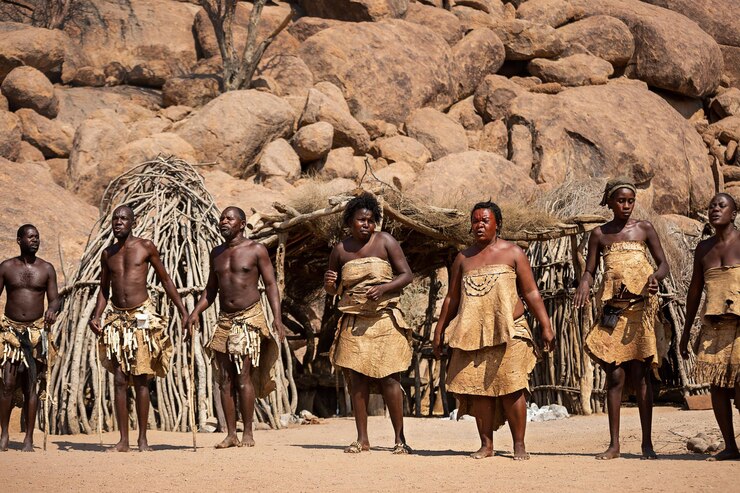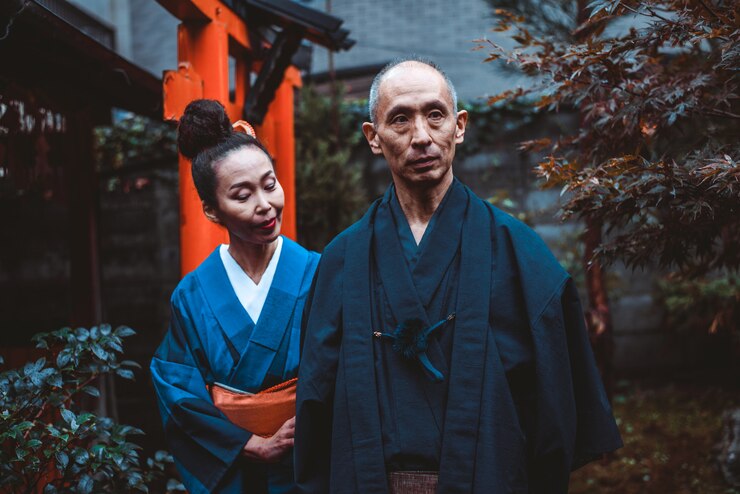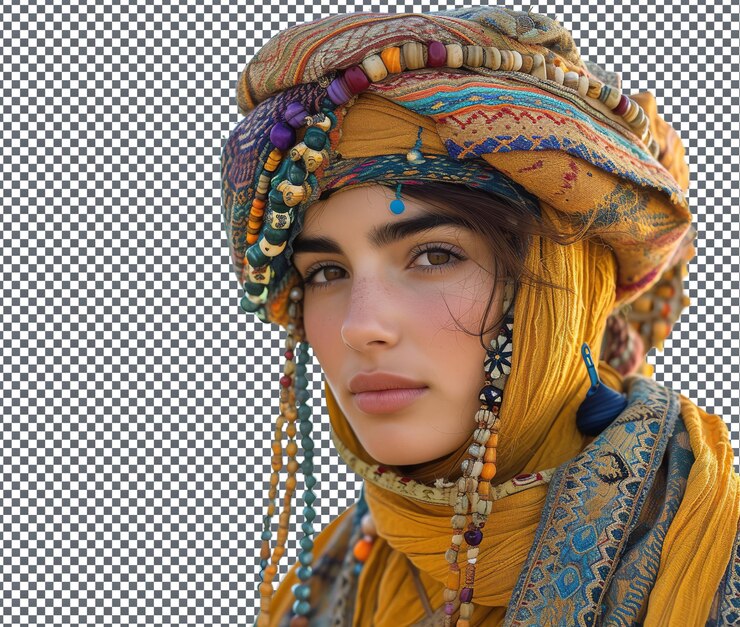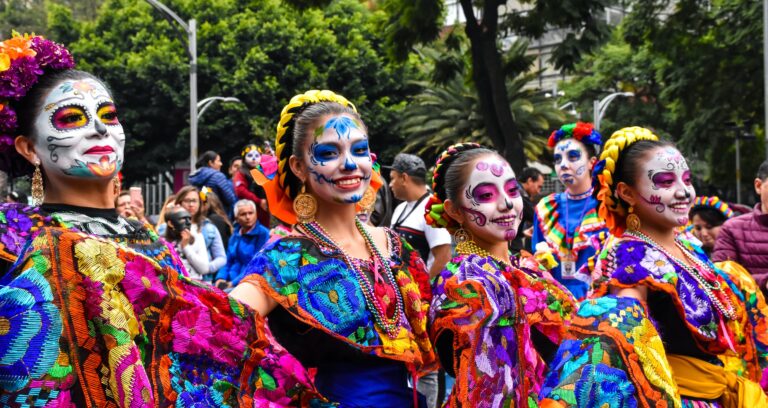The Himba Tribe: An Insight into Namibia’s Fascinating Nomadic Past
Welcome to the enchanting world of the Himba tribe, a fascinating group that has captivated explorers and anthropologists for centuries. Nestled in the arid landscapes of Namibia, this nomadic community boasts a rich history and vibrant culture that is both intriguing and awe-inspiring.
Imagine stepping into a realm where time seems to stand still, where ancient traditions are upheld with unwavering devotion, and where the beauty of simplicity reigns supreme. This is what awaits you as we delve into the captivating world of the Himba people – an opportunity to unravel their unique customs, daily life rituals, and deep-rooted beliefs.
Join us on this extraordinary journey as we uncover the secrets of one of Africa’s most enigmatic tribes – welcome to our exploration into Namibia’s mesmerizing past! Get ready to be transported through time and immerse yourself in a cultural tapestry unlike any other. So grab your virtual backpacks as we embark on an adventure filled with discovery, admiration, and respect for this extraordinary tribe .
The history of the Himba tribe
The history of the Himba tribe is as fascinating as it is ancient. For centuries, this nomadic group has roamed the vast lands of Namibia, leaving traces of their rich heritage along the way. They are believed to have originated from Angola and migrated southwards, eventually settling in what is now northwestern Namibia.
These resilient people have endured countless challenges throughout their history, including colonization and modernization. Despite these obstacles, they have managed to preserve their unique traditions and customs, passing them down through generations. Today, the Himba tribe stands as a testament to the strength and resilience of indigenous cultures in Africa.
Culture and Daily Life
The Himba tribe of Namibia has a rich and vibrant culture that is deeply intertwined with their daily lives. Their way of life revolves around a subsistence economy, where they rely on farming, herding, and gathering for their sustenance. This close relationship with nature shapes their customs, traditions, and overall lifestyle.
Clothing and hair style play significant roles in the culture of the Himba people. The women often adorn themselves with intricately braided hairstyles and wear traditional clothing made from animal skins or fabrics decorated with intricate beadwork. These elaborate hairstyles and garments not only serve as expressions of beauty but also hold symbolic meanings within the community.
Customary practices are an integral part of Himba society. From birth rituals to initiation ceremonies to marriage traditions. Every stage of life is marked by distinctive customs that strengthen social bonds within the tribe. Additionally, communal participation is highly valued in decision-making processes, ensuring that everyone’s voice is heard.
Religion holds great importance among the Himba people. They believe in a supreme being called Mukuru who governs over all aspects of their lives. Rituals such as ancestor worship and spiritual healings are performed to maintain harmony between the living and ancestral spirits.
In modern times, there have been influences from Western cultures which have had both positive and negative impacts on the Himba way of life. Since Namibian independence in 1990, efforts have been made to preserve their cultural heritage while providing access to education and healthcare services for tribal members.
The unique characteristics and traditions embedded within Himba culture make them truly fascinating to learn about! For example, studies have shown that they perceive colors differently due to specific linguistic terms used for certain hues.
Subsistence economy
The Himba tribe, with their rich cultural heritage and nomadic lifestyle, have relied on a unique subsistence economy for centuries. Living in the desolate landscapes of Namibia, they have mastered the art of survival in harsh conditions.
Their economy is primarily based on livestock herding, with goats and cattle being their most valuable assets. These animals provide them with milk, meat, hides for clothing and shelter, as well as a means of trade. In addition to herding, the Himba also engage in agricultural activities such as cultivating maize and millet in small plots. This self-sufficient way of life allows them to maintain their traditional practices while adapting to modern challenges.
With their deep connection to nature and resourcefulness, the Himba people exemplify resilience and adaptability. They embody an ancient way of life that continues to thrive amidst the ever-changing world around them. The subsistence economy sustains not only their physical needs but also serves as a symbol of their cultural identity within Namibia’s diverse landscape.
Clothing and hair style
The clothing and hair styles of the Himba tribe are not just fashion choices but significant cultural expressions. The Himba people are known for their unique attire, which consists mainly of skirts made from animal skins or fabric. Adorned with intricate beadwork and cowrie shells. Men typically wear loincloths and occasionally wrap themselves in blankets during colder weather.
As for their hair, the Himba women take great pride in their elaborate hairstyles. They carefully craft a mixture of red ochre pigment, butterfat, and herbs to create a distinctive reddish coating on their braided locks. This traditional hairstyle is not only aesthetically striking but also serves as a symbol of identity within the community. The attention to detail and artistry displayed in both clothing and hair reflect. The deep-rooted traditions that have been passed down through generations among the Himba tribe.
Customary practices
Customary practices are an integral part of the Himba tribe’s rich cultural heritage. Passed down from generation to generation, these traditions play a vital role in shaping their identity and way of life. From birth rituals to marriage ceremonies, every aspect of their customs holds deep significance.
One notable customary practice is the initiation ceremony for young men and women. This rite of passage marks the transition into adulthood and is accompanied by elaborate rituals that symbolize maturity and responsibility. Another important practice is the healing ceremonies performed by traditional healers known as “omumbandja.” These healers use herbal remedies and spiritual rituals to treat various ailments within the community.
The Himba also have unique wedding customs that emphasize family bonds and unity. Marriage involves intricate negotiations between families. With bride wealth being exchanged as a sign of respect and gratitude. The bride’s appearance on her wedding day is strikingly adorned with traditional jewelry, elaborate hairstyles. And intricately designed body paint made from natural pigments.
Their ancestral beliefs shape many aspects of daily life, including how they interact with nature. Rituals such as rainmaking ceremonies express their close connection to the land and its resources. The Himba believe in ancestor worship as well, honoring their forefathers through prayers and offerings.
These customary practices not only preserve their cultural heritage but also foster a strong sense of community among tribe members. By adhering to these traditions, they maintain a distinct identity that sets them apart from surrounding cultures while showcasing Namibia’s diversity.
Societal participation
The Himba tribe is known for their strong sense of community and societal participation. In the Himba culture, every member has an important role to play in the functioning of their society. From a young age, children are taught the values of cooperation and teamwork, which are essential for the survival and well-being of the entire tribe.
Societal participation among the Himba extends beyond just meeting basic needs. It involves active involvement in decision-making processes, resolving conflicts within the community, and contributing to communal projects such as building homes or tending to livestock. This collective approach ensures that everyone’s voice is heard and that decisions made benefit the entire group rather than individual interests. The strong bond between members fosters a sense of unity and support that is integral to their way of life.
Religion
Religion plays a significant role in the lives of the Himba tribe, shaping their beliefs and guiding their daily practices. Their spiritual system is deeply rooted in ancestor worship and animism. The Himba believe that their ancestors continue to exist after death and can influence the living world. They communicate with these spirits through sacred rituals and ceremonies conducted by traditional healers known as shamans.
These religious practices are intertwined with nature, as the Himba view their surroundings as sacred spaces inhabited by both worldly beings and ancestral spirits. They seek guidance from these spirits for various aspects of life, including health, fertility, and protection against evil forces. Religion provides a sense of identity and purpose for the Himba people, reinforcing their connection to their heritage and sustaining them through the challenges of nomadic life in Namibia’s harsh desert environment.
Traditional Practices in Modern Times
The Himba tribe, known for their deep-rooted traditions, has managed to preserve their cultural practices even in the face of modernization. While some aspects may have evolved over time, many traditional practices continue to be an integral part of their daily lives.
One significant aspect is the link between the Himba tribe and Western culture. With increased contact and exposure to the outside world, elements of Western influence have seeped into their traditions. For example, they now use modern tools such as plastic containers alongside traditional pottery for water storage. This blending of old and new showcases the adaptability and resilience of this fascinating tribe.
Since Namibian independence in 1990. Efforts have been made to protect indigenous communities’ rights. Including those of the Himba tribe. These initiatives aim to ensure that their unique way of life is preserved while allowing them access to education. And healthcare facilities previously unavailable. By striking a balance between tradition and progress.It is hoped that future generations will continue to embrace .Their heritage while embracing opportunities for growth.
Links with Western culture
The Himba tribe, with their rich cultural heritage and unique way of life, have managed to maintain a strong connection to their traditional practices despite the influences of Western culture. However, in recent years, there has been an increasing interaction between the Himba people and the outside world.
With improved transportation and communication networks, Western influences have slowly made their way into Himba communities. The introduction of modern technology such as smartphones and televisions has allowed for greater exposure to Western ideas and lifestyles. This increased contact with the outside world has led to some changes in the way the Himba tribe lives and interacts with others. While some members of the tribe have embraced aspects of Western culture, many still hold onto their traditional customs and values tightly.
While there may be links developing between the Himba tribe and Western culture, it is important to recognize that these interactions are complex and multifaceted. The Himba people continue to navigate how best to preserve their traditions while also engaging with elements from other cultures. It is through this delicate balancing act that they strive to maintain a sense of identity rooted in their nomadic past.
Since Namibian independence
Since Namibian independence in 1990, the Himba tribe has experienced both challenges and opportunities. The introduction of modern infrastructure and services has brought advancements to their daily lives. However, it has also resulted in increased contact with Western culture, which has influenced traditional practices.
With improved access to education and healthcare, younger generations have been exposed to different ideas and lifestyles. This exposure has led to a gradual shift away from some traditional customs and beliefs. Despite these changes, the Himba people continue to preserve their unique cultural heritage through initiatives such as tourism and cultural festivals. It is an ongoing journey for the Himba tribe as they navigate preserving their traditions while embracing the benefits that come with progress.
Human rights
The Himba tribe, with their ancient traditions and unique way of life, have faced numerous challenges in the modern world. One of these challenges relates to human rights. The Himba people have experienced a lack of recognition and protection for their rights, including issues such as land ownership and cultural preservation.
In recent years, efforts have been made to address these concerns. And protect the human rights of the Himba tribe. Non-profit organizations and government agencies are working together to promote awareness and advocate for the rights of indigenous communities like the Himba. However, there is still much work to be done in ensuring that the rights of this fascinating nomadic group. Are respected and upheld in today’s changing world.
Unique Characteristics and Traditions
Color perception and vision play a unique role in the lives of the Himba tribe. Their language and culture have shaped their ability to perceive colors differently from most people. The Himba have distinct words for different shades of red. While other colors are often described more broadly. This fascinating characteristic adds an intriguing layer to their traditions and way of life.
Photographs are a powerful medium through which we can catch a glimpse into the world of the Himba tribe. These images capture their vibrant clothing, intricate hairstyles, and striking adornments with remarkable detail. They offer us a window into their daily lives, allowing us to appreciate their rich cultural heritage from afar. Movies also provide another avenue for exploring the unique customs and traditions of the Himba people, bringing their stories to life onscreen for all to see.
Color perception and vision
The Himba tribe has a unique perspective on color perception and vision. Their way of seeing the world is influenced by their environment and cultural practices. The Himba people live in the arid regions of northern Namibia. Where the landscape is dominated by red sand dunes and rocky outcrops. This vibrant natural backdrop has shaped their understanding of colors.
For the Himba, certain shades hold deep significance. They have distinct words for various hues, including variations of red, which they consider to be an essential color in their culture. This emphasis on specific colors extends beyond language – it also affects how they dress and adorn themselves. The Himba women are known for covering their bodies with a mixture of ochre pigment, butterfat. And aromatic herbs that gives their skin a reddish hue. This unique practice not only protects them from harsh sunlight but also reflects their strong connection to nature.
The relationship between colors and symbolism runs even deeper among the Himba people. Different hues are associated with particular stages of life or spiritual beliefs within the community. For example, white represents purity and spiritual cleansing, while black signifies death or mourning rituals. These associations add depth to everyday interactions among tribe members – from choosing clothing to engaging in social ceremonies.
Color perception plays a significant role in shaping the worldview of the Himba tribe. Their environment has contributed to a heightened awareness and appreciation for different shades, with red being particularly important culturally. Through distinctive practices like body painting with reddish pigments and attaching symbolic meanings to various hues, the Himba maintain a rich visual tapestry that reflects both their identity as nomadic tribespeople and their harmonious relationship with nature’s vibrant palette .
Photographs
Photographs are powerful tools that capture moments in time, preserving them for future generations to see and experience. For the Himba tribe, photographs serve as a visual record of their unique culture and way of life. Through these images, we get a glimpse into their vibrant traditions, striking hairstyles, intricate jewelry, and distinctive red ochre skin adornment.
The vivid colors and raw emotions captured in these photographs transport us to the heart of the Himba community. We can almost feel the warmth radiating from their smiles, sense the pride they take in their appearance, and understand the deep connection they have with their land. These snapshots provide an intimate window into a world that is both ancient and ever-evolving; a testament to the resilience of this remarkable nomadic tribe.
Movies
Movies have the power to transport us to different worlds and cultures, allowing us to explore places we may never physically visit. When it comes to the Himba tribe, movies provide a unique glimpse into their fascinating way of life. Through captivating storytelling and stunning visuals, filmmakers have shed light on the traditions, customs, and struggles experienced by the Himba people.
In these films, viewers are taken on a journey deep into the heart of Namibia’s remote regions where the Himba reside. From breathtaking landscapes to intimate portrayals of everyday life, movies offer an immersive experience that can awaken our curiosity and deepen our understanding of this remarkable tribe. Whether it’s a documentary or a fictional narrative inspired by real events, these cinematic creations allow us to witness firsthand the resilience and beauty inherent in Himba culture.
Conclusion
The Himba tribe, with their rich history and fascinating cultural traditions, continue to captivate and intrigue. Their nomadic past, rooted in ancient customs and beliefs, has shaped their unique way of life. From their subsistence economy to their distinctive clothing and hairstyles, the Himba people have managed to preserve their traditions despite the encroachment of modernity.
In modern times, the Himba tribe has faced challenges in maintaining their traditional practices while also embracing aspects of Western culture. Namibia’s independence brought about changes for the tribe but also raised questions about human rights and cultural preservation. Despite these complexities, the enduring legacy of the Himba tribe remains a testament to their resilience and determination.
The enduring legacy of the Himba tribe
The Himba tribe has left an indelible mark on Namibia’s history and culture. Their nomadic past, rich traditions, and unique way of life have fascinated people from around the world. Despite facing challenges in adapting to modern times, the Himba continue to preserve their customs, language, and beliefs.
The enduring legacy of the Himba tribe lies not only in their distinctive appearance but also in their resilience and determination to maintain their cultural identity. Their ability to adapt while holding onto age-old practices is a testament to their strength as a community.
As we delve into the fascinating world of the Himba tribe, it becomes evident that they possess a wealth of knowledge about survival in harsh environments and sustainable living. The deep connection they have with nature teaches us valuable lessons about our own relationship with the environment.
Moreover, through their colorful clothing, intricate hairstyles, and symbolic body adornments, the Himba express themselves artistically while also sending messages about social status and identity. This serves as a reminder that culture is not stagnant but rather evolves over time.
In recent years, increased contact with Western culture has presented both opportunities and challenges for the Himba tribe. While some aspects of modernity have brought improvements such as access to education and healthcare facilities, there are concerns regarding potential loss of traditional values.
Additionally, since Namibian independence in 1990s . Efforts have been made by various organizations to protect Indigenous rights. However, the delicate balance between preserving cultural heritage while promoting development remains an ongoing challenge for policymakers.
Despite these obstacles, the spirit of the Himba people endures – inspiring curiosity, tolerance, and respect among those who encounter them.







